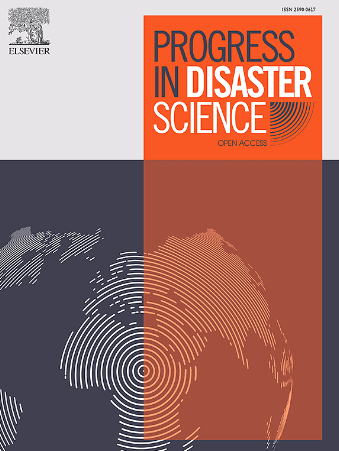Appraising investments in Disaster Risk Reduction (DRR): A systematic literature review
IF 3.8
Q3 ENVIRONMENTAL SCIENCES
引用次数: 0
Abstract
Investments, including those allocated for Disaster Risk Reduction (DRR), need to be appraised before project implementation. Despite scholars' efforts to evaluate DRR investments over the years, a notable gap exists in the literature regarding systematic reviews focused on this topic. Therefore, this study aims to address this gap by conducting a systematic literature review of previous studies assessing the feasibility of DRR investments. The dataset for this review comprised 87 articles sourced from the Scopus database. The findings have been presented according to the research questions of the study, the methods used for appraisal of DRR investments, the types of costs and benefits considered, and the strengths and limitations identified by studies related to the appraisal techniques. Additionally, bibliographic data, the types of hazards considered for DRR investments, and the study contexts were identified. Notably, a significant portion of studies focused on the USA, with investments for flood mitigation representing the majority of investment appraisals. The findings highlighted that cost-benefit analysis was the predominant method used for evaluating DRR investments. Generally, cost estimation was straightforward, which included the initial investment and the maintenance expenses. However, discrepancies exist in the benefits considered by different researchers and the approaches used to quantify them. Based on these findings, the authors suggest future research directions and recommendations aimed at enhancing investment appraisals for DRR.
减少灾害风险投资评估:系统文献综述
投资,包括为减少灾害风险(DRR)分配的投资,需要在项目实施前进行评估。尽管学者们多年来一直在努力评估DRR投资,但关于这一主题的系统综述的文献中存在明显的差距。因此,本研究旨在通过对以往评估DRR投资可行性的研究进行系统的文献综述来解决这一空白。本综述的数据集包括来自Scopus数据库的87篇文章。研究结果是根据研究的研究问题、评估减灾风险投资所使用的方法、所考虑的成本和收益类型以及与评估技术有关的研究确定的优势和局限性提出的。此外,还确定了文献数据、DRR投资考虑的危害类型和研究背景。值得注意的是,很大一部分研究集中在美国,投资评估的大部分是用于防洪的投资。调查结果突出表明,成本效益分析是评价减少灾害风险投资的主要方法。一般来说,成本估算是直截了当的,它包括初始投资和维护费用。然而,不同的研究人员所考虑的益处和用于量化它们的方法存在差异。在此基础上,作者提出了未来的研究方向和建议,旨在加强风险风险投资评估。
本文章由计算机程序翻译,如有差异,请以英文原文为准。
求助全文
约1分钟内获得全文
求助全文
来源期刊

Progress in Disaster Science
Social Sciences-Safety Research
CiteScore
14.60
自引率
3.20%
发文量
51
审稿时长
12 weeks
期刊介绍:
Progress in Disaster Science is a Gold Open Access journal focusing on integrating research and policy in disaster research, and publishes original research papers and invited viewpoint articles on disaster risk reduction; response; emergency management and recovery.
A key part of the Journal's Publication output will see key experts invited to assess and comment on the current trends in disaster research, as well as highlight key papers.
 求助内容:
求助内容: 应助结果提醒方式:
应助结果提醒方式:


